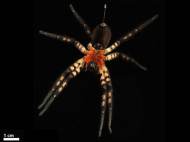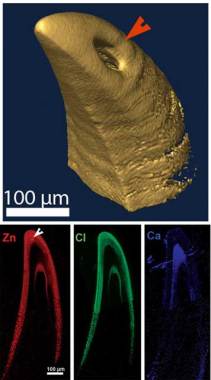Spider’s venomous fang could inspire new tailor-made materials
 Researchers of the Max Planck Institute (MPI) of Colloids and Interfaces in Potsdam, the MPI of Microstructure Physics in Halle and the University of Vienna have investigated the composition and structure of spider fangs which serve as reusable hypodermic needles used to inject paralyzing venom into their prey. The findings may lead to development of materials for special applications or hypodermic syringes with special shapes and material properties for medical applications.
Researchers of the Max Planck Institute (MPI) of Colloids and Interfaces in Potsdam, the MPI of Microstructure Physics in Halle and the University of Vienna have investigated the composition and structure of spider fangs which serve as reusable hypodermic needles used to inject paralyzing venom into their prey. The findings may lead to development of materials for special applications or hypodermic syringes with special shapes and material properties for medical applications.
The material of the shell and armor of arthropods, such as arachnids, insects and crustaceans, is composed of a multitude of extremely fine layers of chitin fibers which we already mentioned in a couple of our older articles. Although their predator’s fangs are consisted out of the same material, the chitin fibers in the fangs of a large Central American wandering spider are arranged and surrounded with proteins in a way that makes the material particularly rigid and thus capable of penetrating its prey’s cuticular armor.
Researchers from the MPI in Potsdam and Halle worked closely with Friedrich Barth, a biologist from the University of Vienna and expert on spiders with particular expertise in their sensory systems and biomechanics. The researchers examined the structure of the material in the fangs of the wandering spider Cupiennius salei, and found out that the fibers in the different layers mainly run in the direction in which high strain trajectories may be expected during biting – a feature which provides tailor-made mechanical resistance of the fangs.
“The highest degree of alignment was found in the mid part of the fang”, said Friedrich Barth. “Remarkably, the fang tip and the outer cuticular layers, which are exposed to the highest strain during biting, mainly consist of proteins.”
The protein matrix in the venom fang is also optimized to serve its function. Since the proteins are characterized by high chemical variability, they can be easily modified to gain a material-technological advantage over the prey. The protein composition changes from the base of the fang to its tip, where the concentration of the amino acid histidine is significantly higher. Histidine is particularly suitable for cross-linking the proteins with metal ions.
The researchers also discovered zinc and calcium in the protein matrix, which made them assume that the neighboring fibers in the protein matrix of the fang tip are cross-linked. This composition enables stable protein matrix also effectively transmits the stress that arises during the penetration of a prey’s cuticular armor to the chitin fibers.
“Spider fangs have a highly specialized material structure. The material properties change in fine gradations from the base to the tip of the fang and the external layer of the fangs seems to be resistant to abrasion”, said Yael Politi, who has studied the spider at close quarters together with her colleagues.
Although the researchers found that chloride ions are a part of the protein matrix, they haven’t managed to discover how they affect the mechanical properties of the fangs since the chloride ions and each of the metal ions are distributed differently in a yet unclear pattern.
Investigating the composition and structure of nature’s materials is useful since it can lead to better properties and lower price of materials we use around us. Further analysis of chemical and structural changes in materials such as one described in this article could lead to custom-tailored, efficient and less expensive materials.
For more information, read the paper published in the journal: “A Spider’s Fang: How to Design an Injection Needle Using Chitin-Based Composite Material”.










Leave your response!